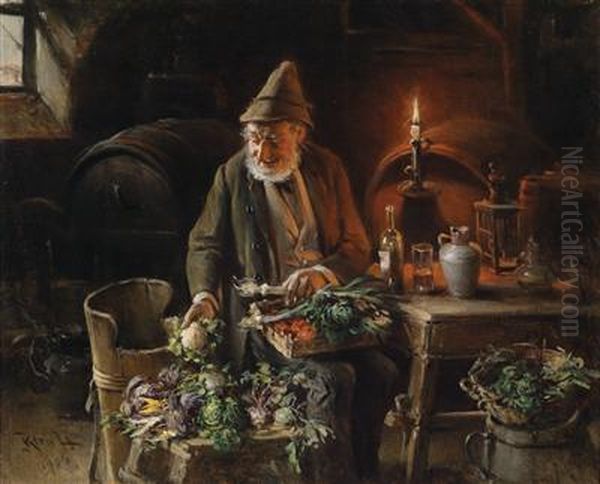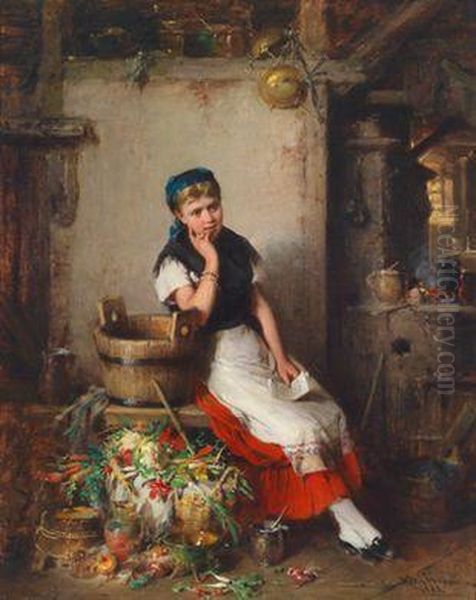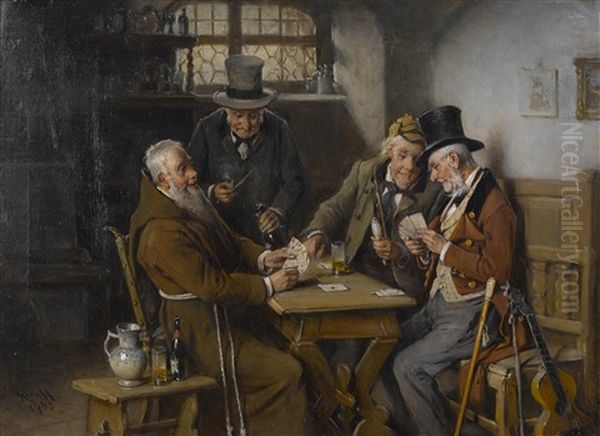Hermann Armin von Kern, a notable figure in 19th and early 20th-century European art, stands as a significant representative of the Academic tradition, particularly within the Austro-Hungarian Empire. Born in 1839 and passing away in 1912, Kern dedicated his artistic career primarily to capturing the nuances of everyday life, earning considerable popularity and even the patronage of the Imperial court in Vienna. His work provides a valuable window into the social fabric, customs, and atmosphere of his time, rendered with meticulous detail and technical skill characteristic of Academic painting.
Origins and Artistic Formation
Hermann Kern's journey began in Liptóvár (now Liptovský Hrádok) or possibly Liptószentmiklós (now Liptovský Mikuláš), towns located in present-day Slovakia, which was then part of the Kingdom of Hungary within the Austrian Empire. This multicultural environment likely influenced his later interest in diverse genre scenes. His artistic inclinations emerged early, leading him to pursue formal training.
His initial studies are believed to have taken place in Pest (part of modern-day Budapest), possibly under the guidance of artists like August von Pettenkofen, known for his depictions of Hungarian and Balkan life. Kern's quest for artistic refinement subsequently took him to Vienna, the vibrant capital of the Empire. There, he enrolled at the prestigious Academy of Fine Arts, immersing himself in the rigorous training methods that emphasized drawing, anatomy, and the study of Old Masters.
Further enhancing his education, Kern sought private instruction from Carl Rahl, a highly influential history painter and teacher in Vienna known for his monumental style. This period undoubtedly honed Kern's technical abilities. His educational path also led him to Munich, another major art center, where he attended the Academy. It was in Munich, around 1870, that he reportedly met and befriended Franz von Defregger, a prominent painter celebrated for his Tyrolean genre and historical scenes. This connection highlights Kern's integration into the broader German-speaking art world.
Style and Thematic Focus

Kern's artistic output is firmly rooted in the Academic style prevalent during his lifetime. This approach prioritized realism, careful composition, a high degree of finish, and adherence to established artistic conventions. He worked primarily in oils, demonstrating a mastery of technique that allowed for detailed rendering of textures, fabrics, and facial expressions. His paintings often exhibit a warm palette and careful attention to light and shadow, contributing to their narrative clarity and atmospheric quality.
Thematically, Kern distinguished himself as a painter of genre scenes. He possessed a keen eye for observing and depicting the everyday activities of ordinary people. His canvases frequently feature scenes set in taverns, workshops, domestic interiors, and marketplaces. He showed a particular affinity for portraying musicians, drinkers enjoying camaraderie, craftsmen at work, families interacting, and children engaged in play. These subjects resonated with the tastes of the burgeoning middle class and the aristocracy of the era, who appreciated relatable yet skillfully executed depictions of contemporary life.
Beyond genre scenes, Kern was also an accomplished portraitist, capturing the likenesses of his sitters with sensitivity and precision. His role as a court painter further attests to his skill in this area. While less common, some sources suggest an engagement with classical ideals, potentially seen in studies or works featuring nudes that emphasized anatomical accuracy and idealized forms, aligning with core tenets of Academic training. His style reflects the broader artistic climate of Vienna during the long reign of Emperor Franz Joseph I, a period characterized by both imperial grandeur and a growing interest in depicting the lives of the populace.
Representative Works
Several paintings stand out as representative of Hermann Kern's oeuvre, showcasing his typical subjects and stylistic approach.
The Beautiful Bassoon: This work exemplifies Kern's interest in musical themes and intimate genre scenes. Often depicting an elderly musician engrossed with his instrument, such paintings capture a sense of quiet dedication and the simple pleasures of life. The detailed rendering of the instrument, the musician's attire, and the surrounding environment are characteristic of Kern's meticulous style. It was reportedly one of his most popular compositions.
Masterfully genre scene with an Austrian wine expert (dated 1869): This painting highlights Kern's ability to create narrative vignettes. It portrays a connoisseur intently examining a glass of wine, likely the famed Johannisberger Riesling mentioned in some descriptions. The scene captures a moment of focused expertise and appreciation, set within a detailed interior, showcasing Kern's skill in rendering textures like wood grain, glass, and fabric, as well as capturing character through posture and expression.

A Painter At The Easel: As the title suggests, this work likely delves into the world of the artist. Such self-referential or studio scenes were common, allowing painters to reflect on their craft. Kern's skill in portraiture would be evident here, capturing the concentration and perhaps the personality of the depicted artist, along with the tools and atmosphere of the studio environment.
The Greengrocer (dated 1906): Painted later in his career, this work demonstrates Kern's continued engagement with scenes of daily commerce and labor. Depicting a vendor, likely in a market setting, it reflects his ongoing observation of everyday life and his ability to portray character types and social settings with realism and detail.
Other works appearing in auction records, such as Botanikers Lieblingblume (The Botanist's Favorite Flower) and In der Küche (In the Kitchen, 1904), further underscore his focus on intimate, character-driven scenes drawn from ordinary life, rendered with his characteristic Academic precision.
Vienna, Court Painter, and Connections
Establishing himself in Vienna was a pivotal move for Kern. The city was not only the political and administrative heart of the Austro-Hungarian Empire but also a major cultural hub. His talent gained recognition, culminating in his appointment as a court painter to Emperor Franz Joseph I. This prestigious position signified official approval and likely brought commissions for portraits and other works, solidifying his status within the Viennese art establishment.
Kern's life in the artistic circles of Vienna and Munich brought him into contact with numerous contemporaries. His friendship with Franz von Defregger (1835-1921) in Munich is noted. Defregger shared Kern's interest in genre scenes, albeit often with a focus on Tyrolean peasant life and historical events, and both operated within the popular Academic-Realist mode.
A particularly interesting connection mentioned in the source material is a close friendship with the renowned composer and pianist Franz Liszt (1811-1886). Kern reportedly even composed some music for the theatre in Szeged, suggesting a versatility beyond painting. This friendship links Kern to the highest echelons of the musical world of the time. However, a mention of musical interaction with Franz Schubert (1797-1828) in one source text is chronologically impossible, as Schubert died before Kern was born; this is likely an error in the source.

Placing Kern in the broader artistic landscape of his time involves considering other prominent figures. In Vienna, the dominant figure for much of Kern's career was Hans Makart (1840-1884), known for his opulent historical and allegorical paintings. Kern's quieter genre scenes offer a contrast to Makart's flamboyant style. Other significant Austrian artists included the Biedermeier master Ferdinand Georg Waldmüller (1793-1865), whose influence on realism and genre painting persisted, and the leading portraitist Friedrich von Amerling (1803-1887). Kern's possible early teacher, August von Pettenkofen (1822-1889), specialized in scenes of Hungarian and Balkan life, sharing an ethnographic interest with Kern.
In the German sphere, particularly relevant due to Kern's Munich connection, were artists like Wilhelm Leibl (1844-1900), a key figure of German Realism, and the highly successful portrait painter Franz von Lenbach (1836-1904). The meticulous realism and historical detail found in the work of Adolph Menzel (1815-1905) in Berlin also provides context, as does the charming Biedermeier genre painting of Carl Spitzweg (1808-1885) in Munich. The Hungarian painter Mihály Munkácsy (1844-1900), who achieved international fame for his dramatic realist scenes, also worked in a somewhat related vein.
Towards the end of Kern's life, the Vienna Secession movement emerged, challenging the dominance of the Academic tradition Kern represented. Figures like Gustav Klimt (1862-1918) and Egon Schiele (1890-1918) ushered in Austrian Modernism, marking a significant stylistic shift away from the detailed realism Kern practiced.
Addressing Potential Confusions
It is essential to distinguish Hermann Armin von Kern, the painter (1839-1912), from other individuals who share the name "Hermann Kern," as this has led to confusion in some accounts.
Firstly, there is Dr. Hermann Kern (1941-1985), a German art historian and museum director who became a leading authority on the history and symbolism of labyrinths and mazes. His seminal work, Labyrinthe: Erscheinungsformen und Deutungen – 5000 Jahre Gegenwart eines Urbilds (published in English as Through the Labyrinth: Designs and Meanings Over 5,000 Years), is a standard text in that field. This Hermann Kern belongs to a different generation and a different discipline; he is unequivocally not the 19th-century painter. Any discussion of labyrinth research, connections to figures like Lars Howlett, or theories about Cretan mazes pertains to this later scholar, not the artist.
Secondly, the name Erwin Kern appears in historical records linked to extremist political violence in the Weimar Republic, specifically the Organisation Consul and the assassination of German Foreign Minister Walter Rathenau in 1922. This individual has no connection whatsoever to the Austrian painter Hermann Kern.
Thirdly, the contemporary Anton Kern Gallery in New York is a prominent space for modern and contemporary art. It was founded by Anton Kern, grandson of the German painter Georg Baselitz. This gallery and its founder are entirely unrelated to the 19th-century Austrian painter Hermann Armin von Kern.
Finally, as noted earlier, the reported musical connection to Franz Schubert is chronologically impossible and must be disregarded as an error stemming from the source material used for the initial query. The connection to Franz Liszt, however, is plausible.
Legacy and Art Historical Position
Hermann Kern occupies a solid, albeit not top-tier, position within the history of 19th-century Austro-Hungarian art. He was a highly competent and successful painter within the Academic tradition, appreciated in his time for his technical skill and engaging subject matter. His role as a court painter to Emperor Franz Joseph I underscores the official recognition he achieved.
His primary contribution lies in his detailed and empathetic portrayal of everyday life. His genre scenes serve as valuable historical documents, offering insights into the customs, attire, interiors, and social interactions of various strata of society, particularly the middle and lower classes, including peasants and artisans. He captured moments of work, leisure, and domesticity with a realism that appealed to contemporary audiences.
While the Academic style he practiced was later overshadowed by Impressionism, Post-Impressionism, and the various currents of Modernism (including the Vienna Secession in his own city), Kern's work retains its value. It represents a significant aspect of 19th-century artistic production and cultural taste. His paintings are appreciated today for their craftsmanship, narrative charm, and their ability to transport viewers back to a specific time and place within the Austro-Hungarian Empire. He remains a notable figure among the many talented artists who chronicled their era through the lens of Academic Realism.
Collections and Market Presence
Based on available information, the works of Hermann Kern are predominantly held in private collections. While he achieved significant recognition during his lifetime, including imperial patronage, his paintings do not appear to be widely represented in the permanent collections of major international public museums today, unlike some of his more famous contemporaries.
However, his work regularly appears on the art market, featuring in auctions across Europe and internationally. The consistent sale of his paintings, often fetching respectable prices, indicates a continued interest among collectors who appreciate 19th-century genre painting and Academic art. The detailed nature and appealing subject matter of his work likely contribute to its enduring market presence. The auction records for pieces like Botanikers Lieblingblume and In der Küche provide concrete examples of this ongoing circulation and valuation.
Conclusion
Hermann Armin von Kern was a quintessential painter of his time and place – the Austro-Hungarian Empire during the latter half of the 19th and early 20th centuries. As a skilled practitioner of the Academic style, he excelled in capturing the texture and character of everyday life through his detailed genre scenes and portraits. From bustling taverns and quiet moments with musicians to depictions of artisans and family life, his work offers a rich visual record of the era. Though perhaps less innovative than the modernists who followed, Kern achieved considerable success, including the prestigious role of court painter, and created a body of work appreciated for its technical proficiency, narrative charm, and documentary value. He remains an important figure for understanding the artistic tastes and social landscape of Vienna and the wider Empire under Franz Joseph I, a chronicler in paint of a world now past.